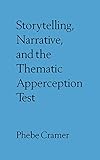Storytelling, narrative, and the thematic apperception test / [electronic resource] Phebe Cramer.
Material type: TextSeries: Assessment of personality and psychopathologyPublication details: New York : The Guilford Press, c1996.Description: viii, 374 p. ; 24 cmISBN:
TextSeries: Assessment of personality and psychopathologyPublication details: New York : The Guilford Press, c1996.Description: viii, 374 p. ; 24 cmISBN: - 1572300949
- 9781572300941
- 616.89075 21
- RC473.T48 C73 1996
- 1996 H-337
- WM 145.5.T3
Includes bibliographical references (p. 341-362) and index.
This volume is about a particular kind of storytelling: the Thematic Apperception Test (TAT). A systematic approach to storytelling, it provides clinicians with an effective method for investigating those original and highly personal themes that constitute the unique personality of each individual. This book illuminates the meaning of narratives and explores their clinical implications by integrating a variety of interpretive approaches to the TAT that are informed by psychodynamic theory and empirical research. The book opens with an overview of the history and development of the TAT. Chapters discuss the importance of context in storytelling, and the relationship between the storyteller's narrative and the story interpreter's narrative in the process of explicating TAT stories. Several psychodynamically informed approaches to interpreting the TAT are placed in a narrative context and illustrated using stories from college students, children, and patients. The ways that stories transform over time are brought to life in an in-depth analysis of both the narratives from the psychiatric patients and information on the course of their treatments. How narratives can reveal different personality organizations is considered, as are the ways in which stories change according to age, gender, or as a result of defense mechanisms. The final section of the book concentrates on the use of the TAT for research studies. Factors that can confound or disrupt these studies are discussed, such as possible ethnic or gender bias in selection of TAT pictures and the influence of the length on the story. Applying contemporary ideas about narrative thought to the TAT, this book is valuable reading for psychologists who use the TAT or any narrative material, such as biographies or interviews, for clinical or research purposes. It also serves as a text for a range of advanced courses in clinical psychology, research methods, and personality assessment.
There are no comments on this title.



























